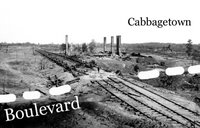
I did a little research on Cabbagetown for you. And because i don't have any recent photos of the girls. so check it out. This is from wikkipedia...
History
The Atlanta Rolling Mill was destroyed after the Battle of Atlanta and on its site the Fulton Bag and Cotton Mill began operations in 1881 and Cabbagetown was built as the surrounding mill town and was the first textile processing mills built in the south. Its primary product was cotton bags for packaging agricultural products. Built during a period when many industries were relocating to the post-Reconstruction South in search of cheap labor, it opened shortly following the International Cotton Exposition, which was held in Atlanta in an effort to attract investment to the region. The mill was owned and operated by Jacob Elsas, a German Jewish immigrant. Its work force consisted of poor whites recruited from the Appalachian region of north Georgia. Elsas built a small community of one and two-story shotgun houses and cottage-style houses surrounding the mill. Like most mill towns, the streets are extremely narrow with short blocks and lots of intersections. At its height the mill employed 2,600 people. A protracted strike in 1914-15 failed to unionize the factory's workforce. For over half a century Cabbagetown remained home to a tight-knit, homogenous, and semi-isolated community of people whose lives were anchored by the mill, until it closed in 1977. Afterwards, the neighborhood went into a steep decline which didn't end until Atlanta's intown renaissance of the mid-1990s. The mill itself was named to the National Register of Historic Places in 1976.
Rebirth
Today Cabbagetown is an area of tremendous growth sparked by Panorama Ray who operated a photo gallery on the main drag, Carroll Street. Since his death in 1997, Carroll Street has become the home of some nice restaurants and makes a great people-watching spot. Beginning in 1996, the mill itself has been renovated into the nation’s largest residential loft community—the Fulton Cotton Mill Lofts—which houses everyone from artists and musicians to business professionals. Although the east building was nearly destroyed by a fire in April 1999, the Fulton Cotton Mill Lofts managed to open the following year.
The main festival is the Cabbagetown Reunion, known colloquially by long time residents and displaced residents as "the vegetable", which takes place in the summer. The Chomp and Stomp takes place in November.
You’ll also find popular restaurants like Agave and Six Feet Under (see listings) as well as the historic Oakland Cemetery, where many of Atlanta’s most famous residents, including Margaret Mitchell are buried.
Origins of the name
There are a few explanations as to how the neighborhood received its name. One is that the mostly transplanted poor Appalachian residents (largely of Scots-Irish descent) who worked in the nearby Fulton Rolling Mill, would grow cabbages in the front yards of their shot-gun houses, and one could distinctly smell the odor of cooking cabbage coming from the neighborhood. This term was used originally with derision by people outside the neighborhood, but it soon became a label of pride for the people who lived there.
Another explanation is that a train carrying a load of cabbages derailed by the mill adjacent to the neighborhood, and the poor residents quickly accumulated the cabbages, and used them in just about every meal. A variation of this legend has a Ford Model T taking a sharp turn at one of the main intersections of Cabbagetown, and flipping over spilling its cargo of cabbages across the street. Someone yelled "Free Cabbages!" and they were soon carted away by the residents.
No comments:
Post a Comment